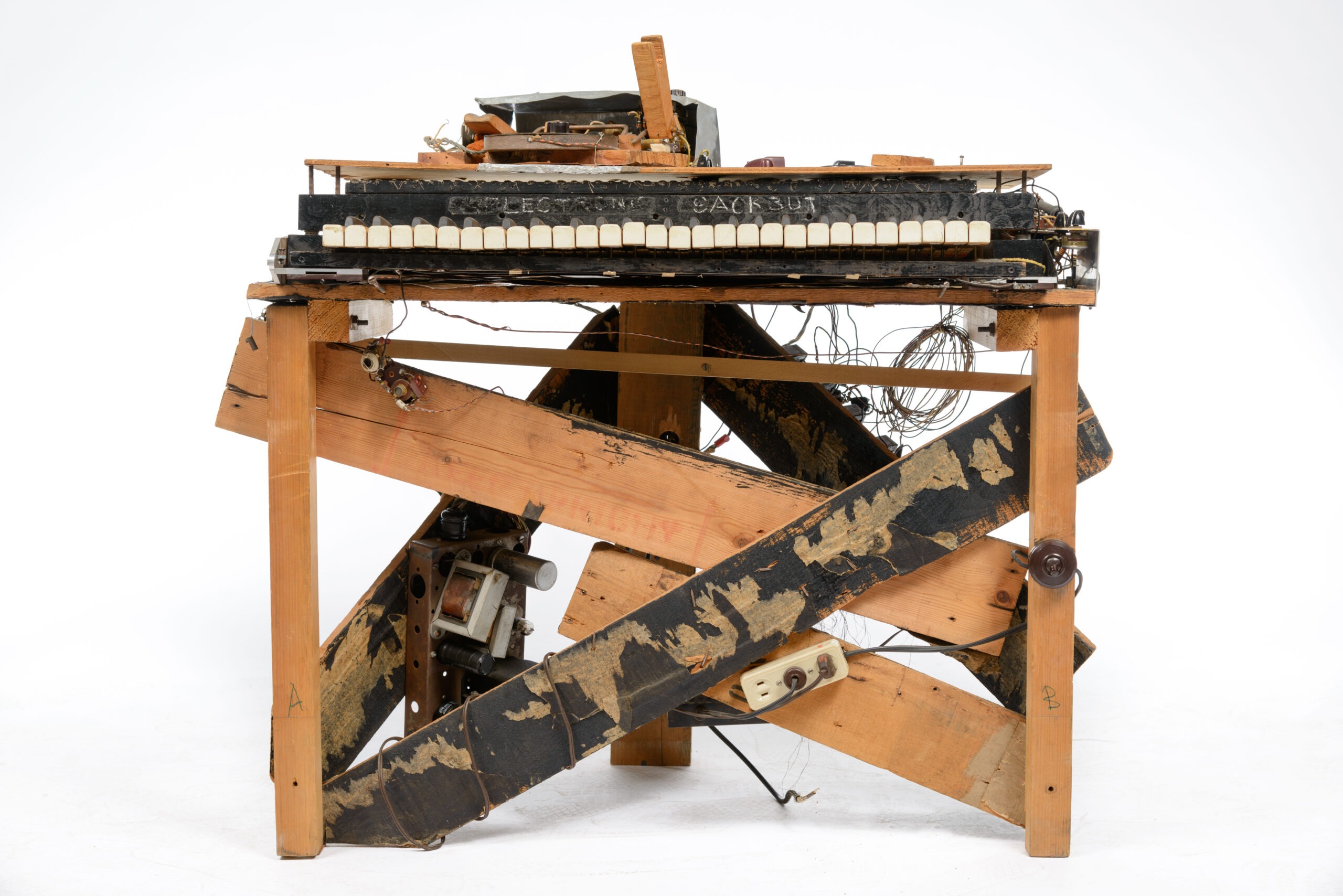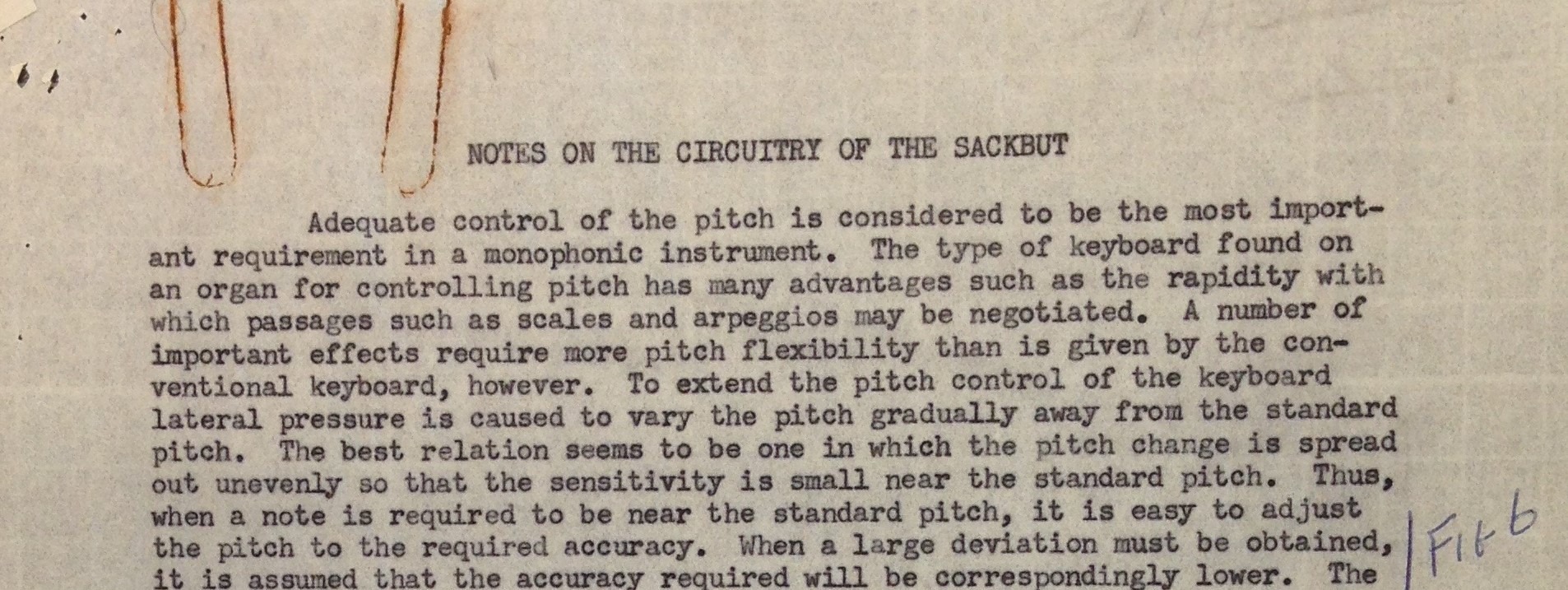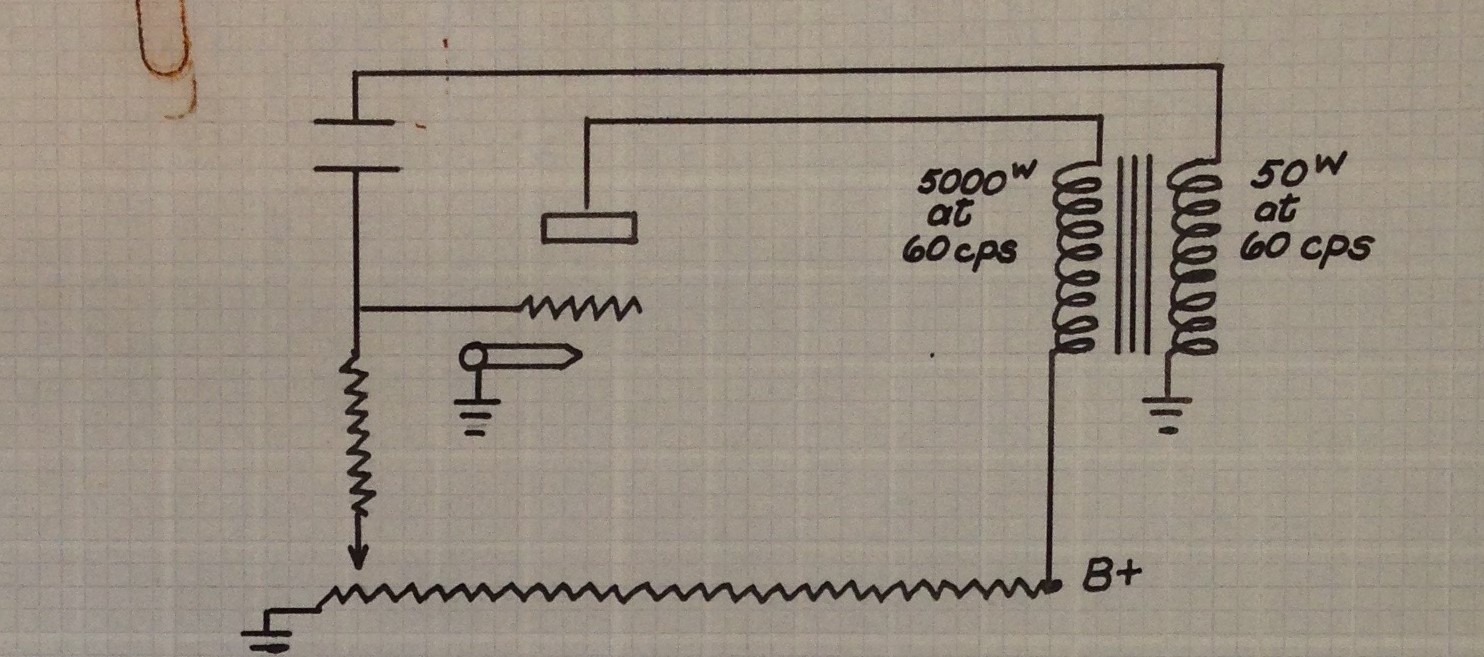A complete draft of the 1948 Electronic Sackbut circuit schematic
- Ezra J. Teboul, Postdoctoral researcher at Ingenium

Context
The circuit schematic presented below represents the electronic design of Hugh Le Caine’s Electronic Sackbut, built between 1945-1948, as it survives in Ingenium’s collection (artifact no. 1975.0336). Hugh Davies, a prominent electronic music historian, saw the Sackbut as potentially “the first synthesizer” (1984); however, it has remained an elusive character in this field. This is in part due to the lack of authoritative definitions for what, exactly, a synthesizer is. More interestingly, it is also because, although the Sackbut’s innovative and unique external control mechanisms have been well discussed, its internal operations have not been thoroughly detailed. That is, until now.
Today we are releasing, under a Creative Commons-Attributions license, the most complete drawing of a schematic of the instrument yet created. This is part of a joint reverse-engineering and reconstruction project which we hope will make Le Caine’s wildly precocious vision of, and enthusiasm for, electronic music more widely appreciated and accessible. It follows an early web-browser emulation of the device, launched in 2023, and a final hardware version, completed in 2025. The latter is a physical reconstruction of the instrument, built by Denis Larouche (structure, aesthetics) and Rowan Nicola (electronics), in collaboration with other subject area experts at Ingenium, that closely mirrors the form and function of the original. Central to this reconstruction is a bespoke digital sound engine, developed by Edmund Eagan, inventor of the EaganMatrix (a custom version of which is a core part of the reconstructed instrument). Le Caine’s main biographer, Gayle Young, has been regularly consulted throughout. The reconstructed version is expected to inform further research on the physical design, playability, and sound of the instrument, in consultation with external experts and musicians.
The 1948 Electronic Sackbut by Hugh Le Caine (artifact no. 1975.0336). Photo credit: Don Kennedy, courtesy of the National Music Centre.
Historical background
Le Caine built the Electronic Sackbut while researching and developing microwave communications technologies at the National Research Center in Ottawa (Recherches au Temps Perdu, p. 34). It materializes his research, between circuit design and instrument design, done mostly prior to his doctoral research at the University of Birmingham in the United Kingdom (1951). It includes components (1N34 solid state diodes and 6AS6 tubes, specifically) which were not commercially available until the later parts of 1948 or later, meaning that the surviving circuit was tinkered with at least as late as the mid-1950s. The last time it was recorded was in 1954, when Le Caine produced a series of demos of the Sackbut for the NRC, and there is no evidence of subsequent play following those recordings. Le Caine spent the next two decades developing a range of other instruments, including an improved Electronic Sackbut, until his retirement in 1974. Ingenium acquired the original 1948 instrument the following year.
Le Caine himself never produced a complete schematic of the original 1948 Electronic Sackbut. This is likely due to the rapidly shifting nature of the prototype. Based on unpublished notes from 1955 (partially pictured in figures 1 and 2), he had described an idealized version of the instrument in a well-known publication (1956), which had been echoed by Thomas Rhea (1980) and extensively contextualized by Gayle Young (1989). And yet, until the Sackbut was made the subject of an in-depth conservation assessment at the National Music Center (Calgary, Alberta) in 2015, no component-level study of the device had been attempted. The partial schematics that were drawn up as one of the outcomes of this project represented, until recently, the most advanced understanding of the instrument’s electronic architecture. These partial schematics helped motivate and inform Ingenium’s Electronic Sackbut Reconstruction Project which, in turn, provided new information on the instrument’s functioning and design. From these partial sketches we assembled the full schematic presented here, so as to encourage considerations of the instrument as a whole, with a particular interest in how different stages are connected. We are now releasing this schematic for public feedback to support our work on finalizing a thorough analysis of the instrument’s inner workings. This is very much a work in progress meant to facilitate another tracing of the circuit in the near future. We expect a general, finalized schematic to answer the open questions we have regarding the device. It will include all part numbers, as many of the missing values as possible, and routing decisions that reflect the pre-existing circuits which inspired Le Caine.
Detail from Hugh Le Caine’s 1955 unpublished draft “Notes on the Circuitry of the Sackbut”. Photo credit: Reproduced with the permission of Library and Archives Canada (2025). © Government of Canada. Source: Library and Archives Canada/Hugh Le Caine Fonds, R14343-0-3-E, MUS 107, Box 9, 2001455996
Technical process and details
As described above, this complete schematic is based on a 2015 circuit trace drafted by John Leimseider at the National Music Center, which resulted in a series of partial schematics. As this latest schematic combines all these partial perspectives, it is the first known document to do so.
This schematic does contain some open questions, many of which are included in the file itself: some component values are missing, some wiring may have been broken between Le Caine’s and Leimseider’s handling of the object—or in transportation—and other sections of the schematics may seem unusual even for a seasoned vacuum tube circuit designer. Unfortunately, Leimseider passed away in 2018: we hope our continued work does his careful and patient labour justice.
Detail from the 1955 document by Le Caine, a simplified description of the “[Basic] Blocking Oscillator.”. Photo credit: Reproduced with the permission of Library and Archives Canada (2025). © Government of Canada. Source: Library and Archives Canada/Hugh Le Caine Fonds, R14343-0-3-E, MUS 107, Box 9, 2001455996
In terms of circuit mechanics, some elements of the design are not surprising: for example, the double-triode-based divider circuits (tubes labeled v1, v2, v3) echo well-documented precedents used in both scientific equipment preceding, or contemporary to, the Sackbut (e.g. the Low Frequency Binary counter circuit used in the Hewlett-Packard AC-4 decade counter, Sect. III p. 2). The transformer coupled blocking oscillator (v4) also has precedents (Schure 1956, p. 3). For other sections, like the 6AS6 pentode-based harmonics subcircuit (v6-9), we could not identify published precedents, but the historical record for tube circuitry is incomplete. If a one pentode clock divider circuit sounds familiar, or if you have HP frequency counter circuit schematics from before 1948, we would love to hear from you. Please reach out at the email below.
In his reference text Electronic and Experimental Music, Thom Holmes discusses aspects of the Sackbut’s left-hand control as “surprising and unpredictable” (2012, p. 199). Although we are not quite done reverse engineering the instrument yet, we can already assess how much of that was due to Le Caine’s design, and how much was due to a lack of documentation. This is a deeply exciting project.
Figure 3: Our working draft of the 1948 Sackbut, based on John Leimseider’s partial schematics (2015). This will be updated as we verify various sections of the circuit. The jpeg, svg and pdf versions are identical, and contain annotations from Leimseider and Teboul. Photo credit: Ezra Teboul for Ingenium
Download as JPEG (11k pixels by 3k (3Mb))
Download as SVG (300kb)
Download as PDF (500kb)
Feedback
We are currently preparing a detailed report on the internal operation of the Sackbut. This will allow the instrument to be better understood in the historical context of other documented electronic music inventions, Canadian electrical engineering projects, and circuit design widely construed. It will assist in a wider discussion of whether Le Caine’s Sackbut did indeed formalize the introduction of voltage control in electronic musical instrument design.
We welcome comments on the current draft schematic. We particularly appreciate suggestions regarding sections which may seem familiar (does this remind you of anything?), or unlikely to function (does this subcircuit look like it would not work?). We’ve made good progress identifying which subcircuits were borrowed from other devices, and which were Le Caine originals, but sadly, we can’t review every diagram ever published and every device ever soldered.
Dr. Ezra J. Teboul, postdoctoral researcher at Ingenium, is the author of the redrawn schematic and the main point of contact for this aspect of the project. They can be contacted at this email: [email protected]
This article is part of the Electronic Sackbut reconstruction project, which aims to create a full-scale, fully-functional reconstruction of the Electronic Sackbut, a keystone artifact in Ingenium’s electronic musical instrument collection. The goal is to give researchers and musicians the opportunity to play this historic instrument for the first time in over 70 years.
References
Davies, Hugh. 2015 (originally 1984). “Le Caine, Hugh.” In The Grove Dictionary of Musical Instruments. Oxford University Press. https://www.oxfordreference.com/display/10.1093/acref/9780199743391.001.0001/acref-9780199743391-e-4319.
Hewlett-Packard Company. 1956. AC-4 Decade Counters: Operating and Service Manual. Palo Alto: Hewlett-Packard Company.
Holmes, Thomas. 2004. Electronic and Experimental Music Pioneers in Technology and Composition. Fourth Edition. New York: Taylor & Francis. Sackbut is discussed pp. 198-199.
Le Caine, Hugh. 1955. Notes on the Circuitry of the Sackbut. Unpublished Manuscript. Hugh Le Caine fonds, R14343-0-3-E, MUS 107, Box 9, reproduction number 2001455996. Ottawa: Library Archives Canada.
———. 1956. “Electronic Music.” Proceedings of the IRE 44 (4): 457–78. https://doi.org/10.1109/JRPROC.1956.274925.
———. 1966. Recherches au Temps Perdu. Unpublished Manuscript. Hugh and Trudi Le Caine Fonds, Folder: 5157, Box 10, File 10. Kingston: Queen’s University Archives. https://db-archives.library.queensu.ca/index.php/recherches-au-temps-perdu
Rhea, Thomas. 1980. “Electronic Perspectives: Hugh Le Caine’s Electronic Sackbut. In Contemporary Keyboard Magazine, December 1980. Reprinted in Electronic Perspectives, 2023, page 328.
Schure, Alexander. 1956. Blocking Oscillators. New York: John F. Rider Publisher, Inc.
Young, Gayle. 1989. The Sackbut Blues: Hugh Le Caine – Pioneer in Electronic Music. Ottawa: National Museum of Science and Technology.




